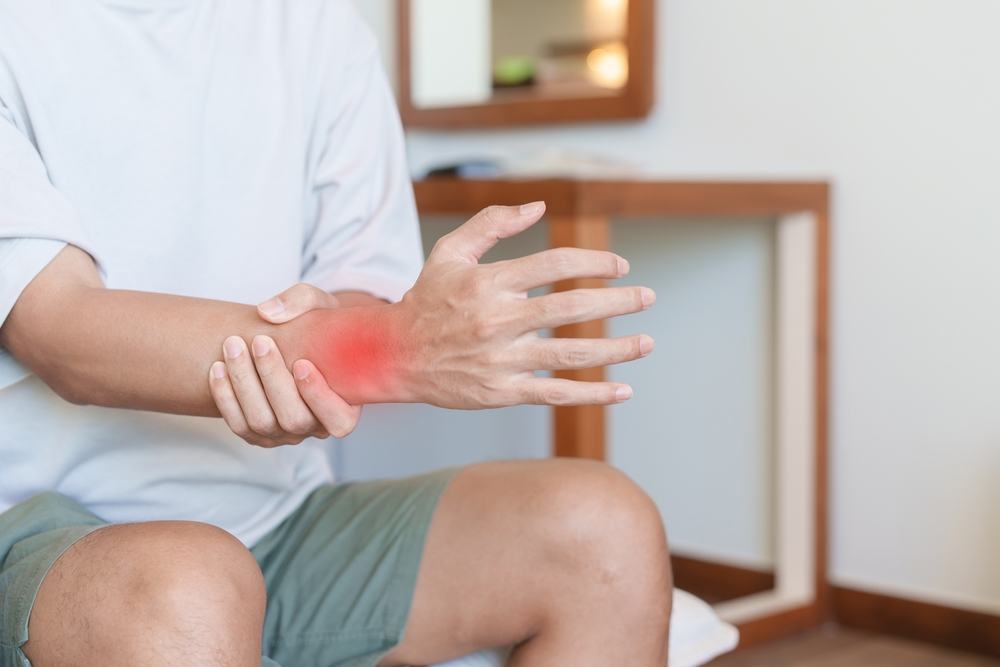 Did you know that the average human body has over 250 joints? Joints are a part of the body where two or more bones meet and support the movement of your skeleton. You rely on your joints for everyday movements like walking, talking, sitting, and standing. In fact, you probably don’t realize just how much you use your joints every second of the day, from brushing your teeth to typing on a keyboard. However, you may become much more aware of certain joints in the body if you start to experience pain or discomfort. Joint inflammation is one of the main causes of joint pain, and there are several different causes. It is important to determine the cause of your joint inflammation to make sure you get the best treatment available. There are also things you can do to support joint health throughout your life that can reduce your risk for joint inflammation. Here’s everything you need to know about joint inflammation, including the various types and causes that may impact you.
Did you know that the average human body has over 250 joints? Joints are a part of the body where two or more bones meet and support the movement of your skeleton. You rely on your joints for everyday movements like walking, talking, sitting, and standing. In fact, you probably don’t realize just how much you use your joints every second of the day, from brushing your teeth to typing on a keyboard. However, you may become much more aware of certain joints in the body if you start to experience pain or discomfort. Joint inflammation is one of the main causes of joint pain, and there are several different causes. It is important to determine the cause of your joint inflammation to make sure you get the best treatment available. There are also things you can do to support joint health throughout your life that can reduce your risk for joint inflammation. Here’s everything you need to know about joint inflammation, including the various types and causes that may impact you.
The Importance of Healthy Joints
Healthy joints are important for several reasons, all of which have to do with how your body functions and ensuring a good quality of life. These are three main reasons why it’s important to have healthy joints no matter how old you are:
Mobility
Healthy joints allow you to move freely and perform a wide range of movements, including walking, running, bending, and lifting. When you have healthy joints, you can perform these common and everyday movements with ease and should not experience pain or discomfort.
Support & Stability
Your joints also provide support and stability to the whole body, especially when performing certain actions like standing or moving around. Various joints have different functions, though they all provide support for an area, like your elbow supporting your arm and associated movements. Joints like the knees also provide stability so you can stand and move around comfortably.
Pain Relief
When you have healthy joints, you are less prone to pain and discomfort, which allows you to go about your day without interference. Healthy joints allow you to function at your best, and when they work correctly, they prevent bones from rubbing together or other uncomfortable and painful issues.
Types of Joints in the Human Body
The human body has many different types of joints that form where two or more bones meet. Joints allow bones to move in relation to each other, which enables you to perform a wide range of movements. These are some of the most common types of joints in the human body:
Ball and Socket Joints
The ball and socket joint allows for a wide range of movement in multiple directions. Two great examples of a ball and socket joint are the shoulder and hip joints. In a ball and socket joint, one bone will have a rounded end (known as the ball) that fits into a cuplike socket on the other bone. This allows for movement in all directions, including bending, straightening, and moving toward and away from the body. The ball and socket joint also allows for rotation and movement in a circular motion.
Fixed Joints
Fixed joints, also known as immovable joints, don’t actually allow for movement. Instead, they provide stability and support to the body. These types of joints are typically held together by strong fibrous tissue and found around bones that need to be very stable, like the bones of the skull. Fixed joints also hold your teeth in place!
Gliding Joints
The gliding joint allows for movement in multiple directions but with a limited range. For example, the wrist and ankle joints are both gliding joints. These joints are made up of two bones that are flattened and smooth, which allows them to glide over one another as the joint moves. Ligaments and cartilage help stabilize this type of joint and reduce friction during movement.
Hinge Joints
A hinge joint allows for movement in only one plane, like the hinge on a door frame. The elbow and knee joints are both examples of hinge joints. For example, if you extend your leg out in front of you and then bend it, this is the only direction the knee can bend in. The two bones that make up a hinge joint are connected by a ligament shaped like a hinge, and one bone has a protrusion that fits into a notch in the other bone.
Pivot Joints
Pivot joints allow for rotational movements, like the connection point between the skull and spine that allows you to turn your head. A pivot joint connects two bones with a small, rounded protrusion on one bone that fits into a circular depression on the other bone. Pivot joints are surrounded by a capsule of ligaments that provide stability to the joint and keep the bones in place. Cartilage also helps provide cushion and reduce friction during movement.
Risk Factors for Joint Inflammation
 Joint inflammation can be caused by a variety of reasons, though there are certain risk factors that may make you more susceptible or increase the likelihood of developing inflammation. It is important to take note of these risk factors and take steps to reduce your risk of developing joint inflammation.
Joint inflammation can be caused by a variety of reasons, though there are certain risk factors that may make you more susceptible or increase the likelihood of developing inflammation. It is important to take note of these risk factors and take steps to reduce your risk of developing joint inflammation.
Age
As you age, your joints can start to wear down, which is known as degeneration. This can occur naturally, as tissues lose their elasticity, because of an injury, or due to another issue. However, the aging process can increase your chances of experiencing joint inflammation.
Genetics
Some people can be more prone to joint inflammation or conditions that cause joint inflammation because of genetic factors. For example, certain types of arthritis can be genetic, meaning this condition that causes joint pain can be inherited from a person’s parents.
Occupation
Your occupation can also put you at risk for dealing with joint inflammation. Jobs that involve high levels of impact or repetitive strain on the joints, like athletics or construction, can increase your risk for joint inflammation.
Other Medical Conditions
Certain medical conditions, like gout or lupus, can cause joint inflammation. Some people experience joint inflammation because of an injury like a car accident injury that can cause pain, inflammation, and damage to joints or soft tissues in the area.
Causes of Joint Inflammation
When many people hear about joint inflammation, arthritis might be the first cause that comes to mind. However, there are many different types and causes of joint inflammation.
Infection
A bacterial or viral infection can cause a joint to become inflamed. Examples of bacteria or other microorganisms that can cause an infection in the joints include streptococcus, the leading cause of strep throat, and staphylococcus, commonly referred to as a “staph” infection.
Injury
An injury to a joint, bone, or nearby tissues can also cause joint inflammation. Trauma to a joint can occur from a fall or sports injury, or you could suffer a joint injury from a car accident. No matter the reason for the injury, joint inflammation can be a common result as the body works to heal the area.
Overuse
Repetitive motions or overuse of a joint can also lead to inflammation. Repeated strain or high levels of impact on a joint can cause the tissues that surround the joint to become inflamed and restrict movement. An overuse injury can also occur and cause more joint pain and also put you at risk for other injuries or issues like sprains or tendonitis. It is important to take breaks and rest any affected joints to allow them time to recover from any overuse.
Medical Conditions
Medical conditions like arthritis can cause inflammation in the joints. Autoimmune disorders can cause joint inflammation when the body’s immune system mistakenly attacks healthy tissues, which can include the joints. Other conditions like psoriasis and inflammatory bowel disease can also contribute to joint inflammation.
Types of Joint Inflammation
Some joints are more prone to inflammation than others due to a variety of factors, including the type of joint, the location, and the amount of stress or strain on the joint. Joints like the knees and hips can be more prone to inflammation because they bear weight and experience repetitive strain. The joints in your hands and feet are also subjected to high levels of wear and tear, which can cause them to be more prone to inflammation. These are the top three types of joint inflammation and how they can impact important joints you rely on every day:
Arthritis
Arthritis actually refers to a group of medical conditions that cause inflammation in the joints. Osteoarthritis is the most common type and occurs as the cartilage cushioning in the joints wears down over time. This can result in the bones rubbing against one another, causing pain, stiffness, and swelling in the joints. Rheumatoid arthritis is an autoimmune disorder where the body’s immune system mistakenly targets healthy tissues, which typically include joints and their surrounding tissues.
Tendinitis
Tendinitis refers to an inflammation of a tendon, which are fibrous tissues that connect muscle to bone. When tendons become inflamed, this can cause irritation and aggravation to nearby nerves. Tendinitis can also impact the healthy functioning of a nearby joint by restricting movement or causing significant pain and discomfort in the area.
Bursitis
Bursitis refers to an inflammation of the bursa, which are small, fluid-filled sacs that cushion and protect joints. Repetitive strain or overuse can result in the bursa becoming inflamed, which can impact joint functioning and cause pain and discomfort.
Treatment Options for Joint Inflammation
 Thankfully, there are several treatment options for joint inflammation that can help reduce your pain and other symptoms. Here are a few options your doctor may discuss with you depending on the type, location, and severity of your joint inflammation.
Thankfully, there are several treatment options for joint inflammation that can help reduce your pain and other symptoms. Here are a few options your doctor may discuss with you depending on the type, location, and severity of your joint inflammation.
Medications
A minor case of joint inflammation may respond effectively to medications like nonsteroidal anti-inflammatory drugs (NSAIDs), including ibuprofen or naproxen, which help to reduce both pain and inflammation. Your doctor may also talk to you about other medications if you have an autoimmune disease, which can help with joint inflammation and slow the progression.
Physical Therapy
Working with a physical therapist will help you strengthen your joints and regain any lost range of motion caused by an injury or condition affecting your joints. Physical therapy provides you with an individualized plan of care, including exercises and stretches to improve your joint health. Your physical therapist can also teach you proper body mechanics and techniques to reduce further joint irritation or injury.
Occupational Therapy
An occupational therapist can help you learn new ways to perform everyday tasks and activities that may be painful or restricted by joint inflammation. These techniques and strategies can also help you identify adaptive techniques or home modifications to help reduce strain on your affected joints.
Assistive Devices
Assistive devices like canes, crutches, or walkers can also help reduce stress and strain on affected joints. These types of devices can also provide you with temporary or long-term support for improved mobility while you manage your joint pain and inflammation. Joint supports and splints can also help reduce strain on your inflamed joints.
Surgery
In some cases, surgery may be necessary to repair or replace a damaged joint. For example, if a joint has been severely damaged by arthritis and non-surgical treatments are not effective in managing your pain and discomfort, then you may need surgery.
How to Maintain Healthy Joints and Prevent Inflammation
Visit AICA Orthopedics in Snellville to learn more about what is causing your joint inflammation and work with our trusted team of doctors. Our Snellville doctors work with joint injuries and conditions and provide each person with a personalized treatment plan so you can get back to your regular routines and activities pain-free. Whether you were recently injured in a car accident or have been diagnosed with arthritis, our team of doctors is here to help. We will also provide you with support as you learn how to maintain healthy joints and prevent joint inflammation going forward, so you can live a better, healthier life!
